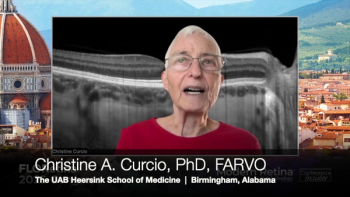
Artificial intelligence analyses biomarker changes in neovascular AMD treated with faricimab
The phase 3 LUCERNE and TENAYA trials suggested that faricimab may allow clinicians to extend the interval between injections to up to 16 weeks after an initial loading phase
German researchers from the Department of Ophthalmology, Ludwig-Maximilians-Universität München University Hospital, Munich, recently reported on the “potential of artificial intelligence (AI)-driven biomarker segmentation as a precise and scalable tool for monitoring disease progression in treatment-resistant neovascular age-related macular degeneration (nAMD).”
They believe this potential will provide clinicians with valuable information about patient responses to treatment,1 according to the lead author Michael Hafner, MD.
Advancements in anti-vascular endothelial growth factor (VEGF) medications to treat AMD have resulted in significant visual improvements for patients. However, not all patients achieve optimal responses, according to the study authors. For patients who do not respond optimally and have persistent macular fluid despite monthly injections or the inability to extend treatment intervals beyond 4 to 6 weeks, the dual mechanism of action of faricimab (Vabysmo, Roche/Genentech) may offer advantages,2,3 the investigators explained.
“The activity of macular neovascularisation in nAMD is commonly indicated by an increase in different optical coherence tomography (OCT) biomarkers such as mean central retinal thickness (CRT) (mean retinal thickness within the 1-mm ETDRS-circle centred on the fovea), and the presence of fibrovascular pigment epithelium detachment (fvPED), subretinal hyperreflective material (SHRM) and macular fluid, including intraretinal fluid (IRF) and subretinal fluid (SRF),” the authors indicated.2,4,5
The phase 3 trials LUCERNE and TENAYA suggested that faricimab may allow for more efficient disease management by extending the interval between injections to up to 16 weeks after an initial loading phase of four monthly doses.6
Study methodology
Dr Hafner and colleagues conducted a retrospective real-world study in which they analysed patients with treatment-resistant nAMD who had been switched to faricimab after having inadequate responses to ranibizumab (Lucentis, Genentech) or aflibercept (Eylea, Regeneron). The safety and efficacy of faricimab was assessed over a 9-month period.
To gauge the effect of faricimab, the investigators conducted automated segmentation of key OCT biomarkers, including fvPED, IRF, SRF, SHRM, choroidal volume and CRT using a deep learning algorithm based on a convolutional neural network.
They explained that to gain a deeper understanding of the mode of action of faricimab and therapeutic progression, investigators must look deeper than the CRT and best-corrected visual acuity (BCVA) and evaluate the biomarkers associated with nAMD.
AI analysis results
A total of 46 eyes (41 patients) completed the 9-month follow-up evaluation.
The investigators found significantly reduced SRF, fvPED and choroidal volume from baseline to 3 months, and the reductions were sustained at 9 months. The CRT also decreased significantly from 342.7 (interquartile range [IQR] 117.1) µm at baseline to 296.6 (IQR: 84.3) µm at 3 months and 310.2 (IQR: 93.6) µm at 9 months.
Dr Hafner and colleagues commented that the deep learning model precisely quantified the biomarkers, enabling reliable tracking of disease progression.
The faricimab injection interval extended from 35 (IQR: 15) days at baseline to 56 (IQR: 20) days at 9 months, representing a 60% increase and reducing the treatment burden. The patients’ visual acuity remained stable throughout the study. Correlation analysis showed that higher baseline CRT and fvPED volumes were associated with greater BCVA improvements and longer treatment intervals.
In commenting on the results, the authors said, “Correlation analysis identified baseline biomarkers, specifically CRT, SRF, and fvPED, as potential predictors of extended treatment intervals, offering valuable insights for personalized therapy optimization. Patients with high baseline CRT and large fvPED volumes also exhibited greater improvements in BCVA, suggesting that specific subgroups may derive enhanced benefits from the dual inhibition of VEGF and angiopoietin-2 by faricimab.”
They believe that integrating AI-assisted OCT analysis into the clinical workflow will improve the precision and efficiency of disease monitoring, and advised that future research should focus on prospective, multicentre validation studies with longer follow-up durations to further assess long-term efficacy of faricimab and refine predictive models for personalised treatment strategies in nAMD.
References
- Hafner M. Eckardt F, Siedlecki J, et al. Deep learning assisted analysis of biomarker changes in refractory neovascular AMD after switch to faricimab. Int J Retin Vitr. 2025;11:44.
https://doi.org/10.1186/s40942-025-00669-2 - Mettu PS, Allingham MJ, Cousins SW. Incomplete response to anti-VEGF therapy in neovascular AMD: exploring disease mechanisms and therapeutic opportunities. Prog Retin Eye Res. 2021;82:100906.
- Ozdemir S, Finkelstein E, Lee JJ, et al. Understanding patient preferences in anti-VEGF treatment options for age-related macular degeneration. PLoS ONE. 2022;17:e0272301.
- Siedlecki J, Fischer C, Schworm B, et al. Impact of sub-retinal fluid on the long-term incidence of macular atrophy in neovascular age-related macular degeneration under treat & extend anti-vascular endothelial growth factor inhibitors. Sci Rep. 2020;10:8036.
- Schmidt-Erfurth U, Chong V, Loewenstein A, et al. Guidelines for the management of neovascular age-related macular degeneration by the European society of retina specialists (EURETINA). Br J Ophthalmol. 2014;98:1144–1167.
- Heier JS, Khanani AM, Quezada Ruiz C, et al. Efficacy, durability, and safety of intravitreal faricimab up to every 16 weeks for neovascular age-related macular degeneration (TENAYA and LUCERNE): two randomised, double-masked, phase 3, non-inferiority trials. Lancet. 2022;399:729–740.
Newsletter
Get the essential updates shaping the future of pharma manufacturing and compliance—subscribe today to Pharmaceutical Technology and never miss a breakthrough.








































